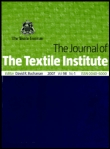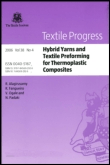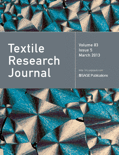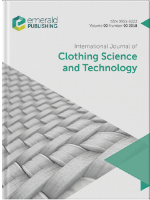
Clothing and Textiles Research Journal
Scope & Guideline
Pioneering research at the forefront of textiles and management.
Introduction
Aims and Scopes
- Sustainability in Fashion and Textiles:
The journal emphasizes research that explores sustainable practices, materials, and technologies in the clothing and textile industry, promoting eco-friendly solutions and the circular economy. - Technological Innovations in Apparel:
A core focus is on the integration of advanced technologies such as 3D printing, machine learning, and virtual reality into clothing design and manufacturing processes, enhancing efficiency and creativity. - Cultural and Social Dimensions of Fashion:
Research examining the intersection of fashion with cultural identity, social justice, and consumer behavior is prevalent, providing insights into how clothing influences and reflects societal values. - Health and Well-being through Textiles:
The journal explores the relationship between textiles and health, including the development of adaptive apparel for individuals with disabilities and the impact of clothing on psychological and physical well-being. - Consumer Behavior and Market Trends:
Investigating consumer preferences, purchasing behaviors, and market dynamics is a key area, offering valuable insights for industry stakeholders.
Trending and Emerging
- Adaptive and Inclusive Fashion:
Research focusing on adaptive apparel for individuals with disabilities and the importance of inclusivity in fashion design is gaining momentum, emphasizing the need for clothing that accommodates diverse body types and abilities. - Digital Fashion and Virtual Environments:
The exploration of digital fashion, including virtual clothing and fashion exhibitions, is a burgeoning area of interest, showcasing how technology is reshaping the fashion landscape. - Sustainability and Upcycling:
The journal increasingly features studies on sustainable practices, including upcycling, the use of recycled materials, and the development of eco-friendly textiles, reflecting a growing commitment to environmental responsibility. - Machine Learning and Data Analytics in Fashion:
There is a rising focus on applying machine learning and data analytics to predict fashion trends, consumer behavior, and optimize design processes, indicating a shift towards data-driven decision-making. - Cultural Identity and Fashion Expression:
Emerging themes related to cultural identity, gender expression, and the intersection of fashion with social justice issues are increasingly prevalent, highlighting the role of clothing as a medium for personal and collective expression.
Declining or Waning
- Historical Fashion Studies:
Research focusing solely on historical fashion trends and garments has seen a decrease, as the journal shifts towards contemporary issues and innovative practices in the fashion industry. - Basic Textile Manufacturing Processes:
Studies centered on conventional textile manufacturing techniques are less frequent, indicating a potential waning interest in traditional methods in favor of advanced technologies and sustainable practices. - Static Consumer Behavior Studies:
Research that examines consumer behavior without considering dynamic factors such as social media influence or technological advancements is becoming less common, as the field moves towards a more integrated approach. - Uniform Design and Functionality:
While still relevant, there is a noticeable decline in research dedicated to school uniforms and their functional aspects, as broader topics related to inclusivity and adaptability gain traction. - Traditional Fabric Dyeing Techniques:
Interest in conventional dyeing methods is declining in favor of studies that explore natural dyes and eco-friendly alternatives, reflecting a broader shift towards sustainability.
Similar Journals

Fashion Practice-The Journal of Design Creative Process & the Fashion Industry
Innovating Insights for the Evolving Fashion Sector.Fashion Practice: The Journal of Design Creative Process & the Fashion Industry, published by Routledge Journals, Taylor & Francis Ltd, serves as a pivotal platform for advancing knowledge in the realms of fashion design and its creative processes. With a focus on the interconnections between design and industry, this journal addresses contemporary issues and innovative practices within the fashion sector, making it an essential resource for researchers, professionals, and students alike. Holding a prestigious Q1 rank in both Cultural Studies and Visual Arts and Performing Arts, it reflects a strong commitment to academic excellence, evidenced by its notable Scopus rankings and an impact factor that positions it among the top 5% of journals in its field. Although it operates on a subscription model, the journal is a valuable investment for those looking to deepen their understanding of fashion's evolving landscape. Since its inception in 2015, Fashion Practice has fostered critical discussions and insights, making it indispensable for anyone seeking to influence the future of the fashion industry.

JOURNAL OF THE TEXTILE INSTITUTE
Advancing textile research for a sustainable future.The Journal of the Textile Institute, published by Taylor & Francis Ltd, is a renowned academic journal that has been pivotal in advancing research and innovation in the textile industry since its inception in 1967. With a robust ISSN of 0040-5000 and an E-ISSN of 1754-2340, this journal serves as a vital resource for researchers, practitioners, and students interested in the multifaceted aspects of textiles, encompassing agricultural and biological sciences, industrial engineering, and materials science. With a respectable impact factor reflected in its Q2 quartile rankings in the 2023 categories of Agricultural and Biological Sciences, Industrial and Manufacturing Engineering, and Polymers and Plastics, the journal stands out in the academic landscape—offering high-quality, peer-reviewed articles that foster knowledge exchange and innovation. Researchers and professionals alike will find this journal's commitment to exploring contemporary challenges and technological advancements ultimately invaluable for both academic inquiries and practical applications in the textile field.

Industria Textila
Exploring Interdisciplinary Solutions for Textile ChallengesIndustria Textila is a prominent academic journal dedicated to advancing knowledge in the fields of textile science, engineering, and related disciplines. Published by the Institutul Național de Cercetare-Dezvoltare Textile Pielarie din București, Romania, this journal has been a key player in the textile research community since its inception in 1994, with a converged publication timeline extending to 2024. With its significant contributions, Industria Textila currently holds a Q3 ranking in various categories, including Business, Management and Accounting, Environmental Science, and Materials Science. Despite its more accessible open access status, researchers are drawn to its rigorous scientific standards and interdisciplinary approach, addressing critical issues in textiles such as sustainability and innovation. The journal's commitment to enhancing understanding of interrelated sectors makes it an invaluable resource for academics, professionals, and students aiming to contribute to the evolving landscape of textile research. With a focus on both applied and theoretical aspects, Industria Textila seeks to bridge gaps between research findings and practical applications, thereby inspiring advancements in the field.

TEXTILE PROGRESS
Transforming Ideas into Textile SolutionsTEXTILE PROGRESS is a premier academic journal published by Taylor & Francis Ltd, dedicated to advancing the field of textiles and materials science. With an ISSN of 0040-5167 and an E-ISSN of 1754-2278, this journal serves as a vital resource for researchers and professionals interested in the interplay between chemical engineering, industrial processes, and manufacturing technologies related to textiles. Covering a wide scope of topics from 1969 to 2024, TEXTILE PROGRESS has established its reputation within the scholarly community, consistently achieving a Q2 ranking in various categories including Chemical Engineering, Industrial and Manufacturing Engineering, and Materials Science as of 2023. Its impressive Scopus rankings – 121st in Industrial and Manufacturing Engineering and 101st in General Chemical Engineering – reflect its significance and relevancy in the academic landscape. While not an open-access journal, TEXTILE PROGRESS ensures accessibility through its extensive distribution channels, enabling students, researchers, and professionals alike to benefit from cutting-edge research and developments in textile technology and science.

TEXTILE RESEARCH JOURNAL
Elevating Knowledge in Chemical Engineering and TextilesTEXTILE RESEARCH JOURNAL, published by SAGE PUBLICATIONS LTD, is a premier academic journal dedicated to the field of textile and materials science, specifically focusing on advances in chemical engineering and polymer technology. With an impressive history dating back to 1931, this journal has continually adapted to the evolving landscape of textile research, aligning its objectives with the latest scientific developments and practical applications. Ranked in the Q2 category for both Chemical Engineering (miscellaneous) and Polymers and Plastics in the 2023 Scopus rankings, the journal serves as a critical platform for disseminating innovative research and groundbreaking methodologies, appealing to researchers, industry professionals, and students alike. While it is not an open-access journal, it remains a vital resource for those seeking high-quality, peer-reviewed literature that bridges the gap between academia and industry. The journal's robust thematic focus and commitment to excellence make it indispensable for anyone looking to stay on the forefront of textile research.

FIBRES & TEXTILES IN EASTERN EUROPE
Exploring the Future of Fibres and Textiles in a Changing WorldFIBRES & TEXTILES IN EASTERN EUROPE, published by the Lukasiewicz Research Network - Lodz Institute of Technology, is a prominent academic journal dedicated to advancing knowledge in the fields of materials science, engineering, and environmental research within the textile industries of Eastern Europe. Since its inception in 1993, this journal has become a vital resource for researchers, professionals, and students alike, focusing on the latest innovations and trends in fiber and textile technology. With an impressive classification of Q3 in several categories, including Business and International Management, Environmental Science, and Industrial Manufacturing Engineering, it aims to bridge the gap between research and practical application. Although it is an open-access journal, readers can easily access valuable insights and findings that are crucial for both academic and industrial stakeholders. As global sustainability and material efficiency become increasingly pressing issues, FIBRES & TEXTILES IN EASTERN EUROPE plays an essential role in disseminating research that addresses these challenges while promoting collaboration across diverse disciplines.

INDIAN JOURNAL OF FIBRE & TEXTILE RESEARCH
Connecting research and practice in the textile industry.INDIAN JOURNAL OF FIBRE & TEXTILE RESEARCH (ISSN: 0971-0426, E-ISSN: 0975-1025) is a leading platform dedicated to advancing the field of textile research and innovation. Published by the NATIONAL INSTITUTE OF SCIENCE COMMUNICATION-NISCAIR in India, this open access journal has been fostering knowledge sharing since its establishment in 2006. With a broad scope encompassing Chemical Engineering, Environmental Science, and Materials Science, the journal's convergence from 1990 to 2024 highlights its commitment to ongoing academic dialogue. Currently categorized as Q3 in several disciplines, including Chemical Engineering and Environmental Science, it provides critical insights into contemporary challenges and developments. The journal's Scopus rankings further illustrate its influence within the research community, making it an essential resource for researchers, professionals, and students interested in textile technology and its intersections with sustainable practices. By fostering a collaborative environment for sharing pioneering research, the INDIAN JOURNAL OF FIBRE & TEXTILE RESEARCH stands as a vital conduit for scholarly communication in the textile sector.

International Journal of Clothing Science and Technology
Exploring Sustainable Solutions for the Fashion Industry.International Journal of Clothing Science and Technology, published by Emerald Group Publishing Ltd, is a leading academic journal dedicated to advancing the field of clothing science and technology. With a commitment to high-quality research since its inception in 1989, this journal effectively bridges the gap between innovation and application within the realms of textiles, fashion, and related materials science. The journal holds a respectable Q3 ranking across several categories, including Business, Management and Accounting (miscellaneous) and Materials Science, emphasizing its relevance in both industry and academia. Although it is not Open Access, the journal nonetheless provides critical insights and findings that are essential for researchers, professionals, and students aiming to navigate the complex world of clothing technology. From sustainable practices to new fabric technologies, the International Journal of Clothing Science and Technology remains a vital resource, equipping its readers with the latest knowledge to drive progress in this dynamic field.

Central European Business Review
Illuminating Trends in International Business DynamicsCentral European Business Review, published by UNIV ECONOMICS-PRAGUE, stands as a pivotal resource in the fields of business and management, particularly focusing on the international dynamics and advancements within Central Europe. Since its inception in 2017, this journal has established a reputation for its commitment to academic rigor, evident in its ranking within the Q3 category for 2023 in key areas such as Business and International Management, Management of Technology and Innovation, and Strategy and Management. With a location in the heart of Prague, the journal aims to provide open access to new insights and research, fostering a collaborative network among scholars, practitioners, and students alike. Although the journal does not currently provide a specific impact factor or HIndex, its Scopus rankings reflect a growing reputation with ranked positions across multiple relevant categories—arousing interest and engagement within both the academic community and industry practitioners. The Central European Business Review is indispensable for those looking to explore contemporary business challenges and innovations in the region.`

npj Flexible Electronics
Innovating Tomorrow's Electronic Solutionsnpj Flexible Electronics, published by NATURE PORTFOLIO, is a premier open-access journal dedicated to the rapidly advancing field of flexible electronics. Since its inception in 2017, the journal has gained significant recognition, boasting impressive rankings as a Q1 journal in both Electrical and Electronic Engineering and Materials Science based on the 2023 metrics. With its E-ISSN 2397-4621, the journal serves as an essential platform for researchers, professionals, and students alike, facilitating the dissemination of high-quality research articles, reviews, and insights that drive innovation across multidisciplinary applications. Operating from its base in Berlin, Germany, and characterized by a robust impact within the academic community, npj Flexible Electronics plays a critical role in shaping the future of electronic materials and devices. The journal offers comprehensive open access options, ensuring that cutting-edge research is readily available and widely disseminated, fostering collaboration and engagement within the global research community.